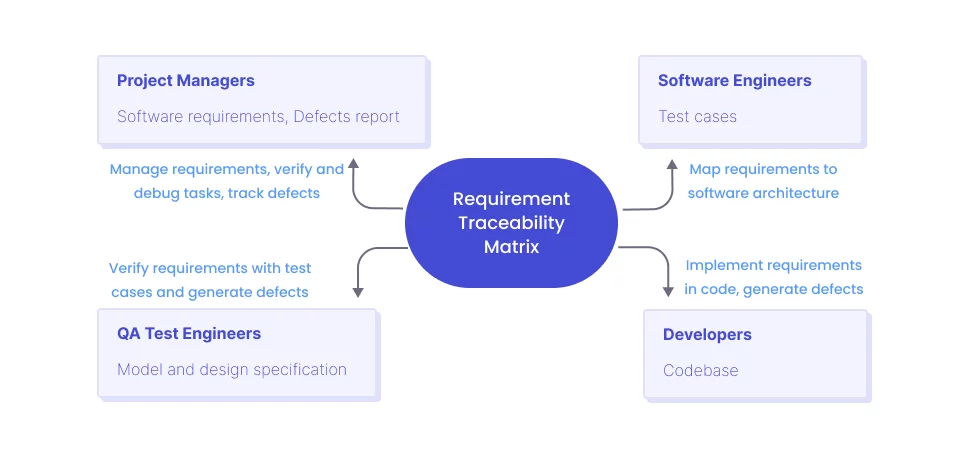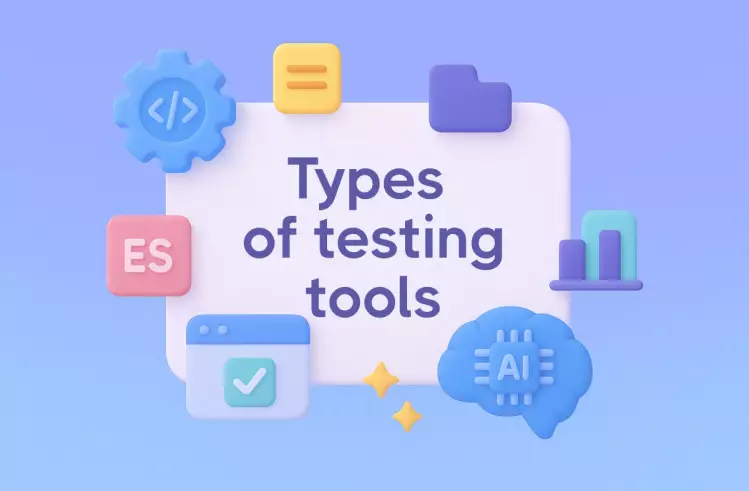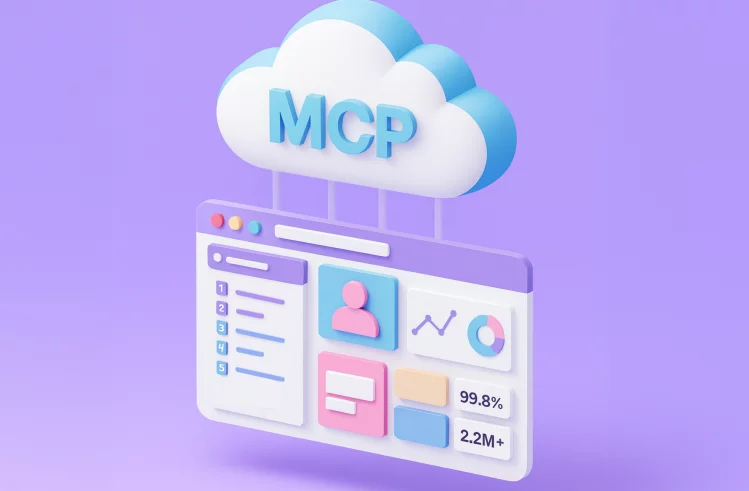In today’s competitive environment, delivering reliable and top-notch software products is crucial for any organization across the globe to succeed. That’s where meticulous testing comes in to help development teams detect potential issues quickly, gradually increase test coverage, and deliver a meaningful experience for users.
However, it is complicated for teams to keep track of all activities when testing projects of different sizes. Thanks to the requirements traceability matrix, it comes in handy for them to monitor and validate each requirement with ease. BTW in our test management system this feature is implemented successfully.
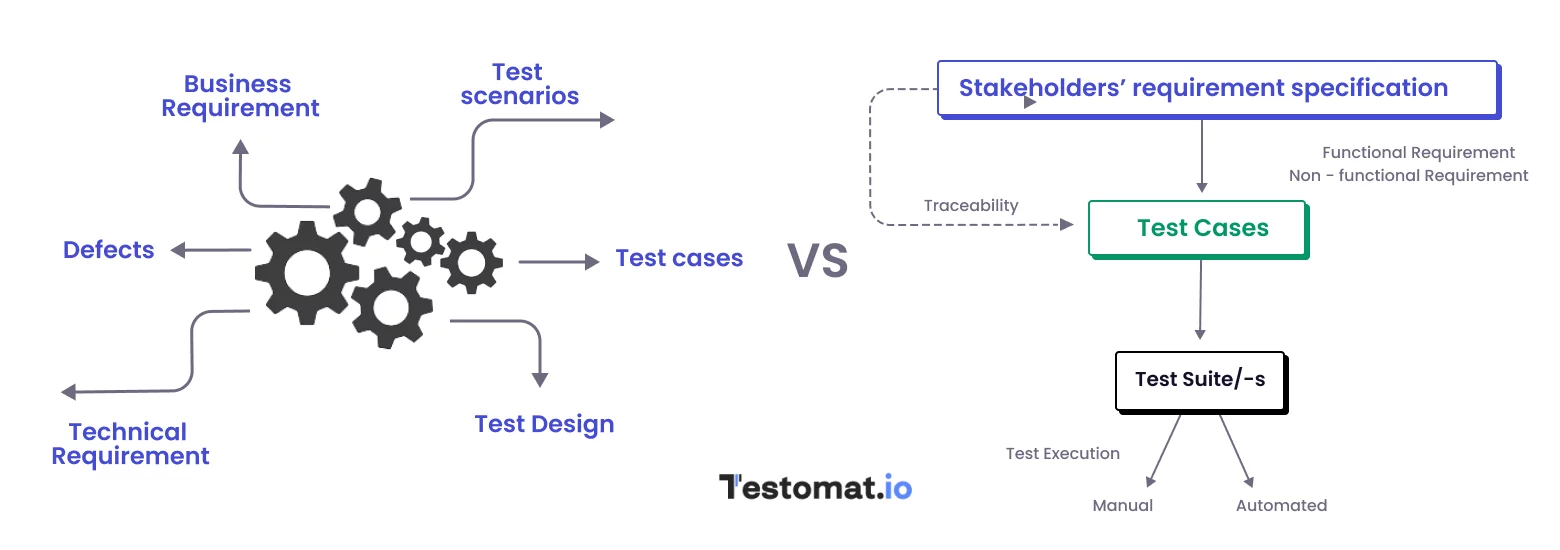
Organizations can not only increase results in better quality of software products and reduce development time but also make business requirements completely traceable across the entire software development. This will give them a competitive advantage, strengthen their reputation, and build trust with clients in the long run.
Requirements Traceability Matrix (RTM): What exactly is it?
If your software product looks good on sketch, it is possible that its features may not work in reality. That’s where a requirements traceability matrix (RTM) will be useful in project management as well as in the actual testing process. Displaying sets of requirements mapped onto the test cases or test scripts, the traceability matrix document ensures the team runs the right tests that verify the project functionality and features work as correctly as expected.
In addition to that, RTM keeps track of correlation between test cases/test scenarios and ensures the team validates each business requirement and catches vital connections, predicting possible error scenarios and catching issues beforehand.
What are the 3 types of requirements traceability matrix (RTM)?
It’s vital to be in the know about the different types of traceability available today. Project managers and testing teams use the following types of traceability in matrices:
#1: Forward traceability
When using this model, teams define the requirements to convert them into test cases. Once clear links connect initial requirements and test cases are established, teams can track the design and implementation of projects. The forward traceability matrix helps ensure that the development process aligns with the specified business requirements and achieves the goals. Moreover, if any requirement lacks a corresponding test case, they can detect a gap in testing coverage that needs to be addressed.

#2: Backward traceability
This model establishes clear links between test cases and the specific requirements to be validated. Backward traceability matrix helps teams ensure that all test cases are based on identified requirements and check that each test case/scenario addresses each project requirement. Generally, this traceability model assures that the testing process aligns with the project’s objectives and allows for a reduction in the use of resources.

#3: Bi-directional traceability
In this model, test cases and requirements are linked in both forward and backward directions in order to check that the tests correlate to requirements, and vice versa. This means the matrix delivers two-way traceability in requirements and test cases, test scenarios and test scripts connected through unique IDs assigned to each requirement and test case/scenario. This helps teams monitor changes on the project and validate them, easily measure the coverage of requirements and make sure the requirements and test cases are in line.

In fact, the traceability matrices intend to present the linkage between project artifacts (such as documents, templates, specs, and outputs) and the set of requirements noted down in the technical requirement document and keep them regularly updated in the requirement traceability matrix throughout the development process. This simplifies traceability and makes sure that the testing team is not missing any critical points of the project where business requirements are validated.
Features of requirements traceability matrix (RTM)
Requirement traceability matrix includes some characteristics that make it an effective tool utilized in project management as well as during the actual testing process.
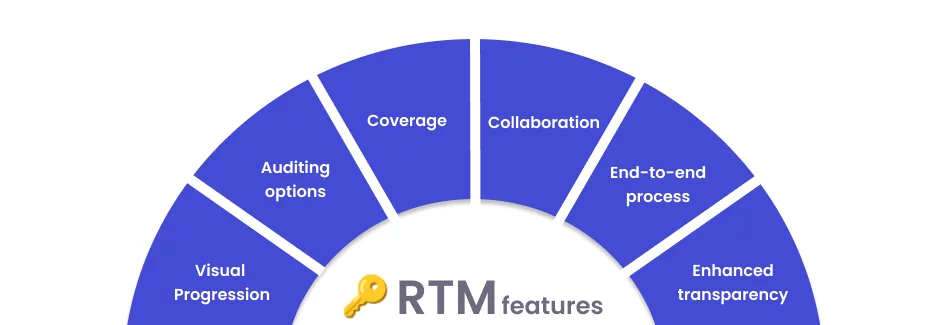
Their description are the following:
- Transparency-based approach. By mapping and linking requirements and artifacts of the project, it drives transparency and ensures traceability during the development process.
- Auditing options. Acting as a documented record showing how the requirements and other project elements are related, requirement traceability matrix reduces the risk of missed business needs and provides a high level of transparency in terms of adherence to the project goals.
- Full completeness and coverage. It means that each requirement is clearly defined and there are no missing links between the set of requirements listed and appropriate elements in the project documentation, including business requirement document and technical requirement document.
- Visibility and reporting: With requirement traceability matrix, the testing team and stakeholders involved can discover shareable formats of the document to gain enhanced visibility by monitoring the coverage of test cases and test runs in each corresponding requirement.
- End-to-end traceability process. It enables simple navigation and understanding of the relations between various project components, including a diverse set of requirements to make sure they fulfill compliance regulations.
Continuous improvement. With a requirement traceability matrix in place, teams can identify areas of improvement, refine processes, and optimize the project’s development and testing efforts. - Boosted team collaboration and performance. Team members, such as business analysts, developers, testers, project managers, and others are in the know about the dependencies between requirements set. Taking that into account, teams are able to take more informed decisions when modifications are required.
Why do QAs and PMs teams need RTM for their projects?
With RTM in place, testing and project management teams can determine what requirements set have been tested efficiently and what requirements still need to be tested.
In addition to that, they can use information from RTM to track and trace the progress of requirement coverage in the development lifecycle. If test coverage is weak, they can create and add appropriate test cases to validate each requirement better and ensure the software product meets the expected objectives.
That’s why if you need to enhance transparency and reduce risks in software testing processes, creating an RTM is a way out for building software products of better quality.
How does the requirements traceability matrix work?
A traceability matrix document visualizes how various project artifacts, such as requirements, test cases, user stories, bugs, etc. are connected. Using a matrix format, you can find out traceability links aligned between a set of requirements and test cases. What’s more, RTM’s format allows team members engaged in the process to track, trace, and manage the progress of the developing software products, as well as confirm that sets of requirements have been adequately changed, tested, and/or implemented. However, there is no fixed algorithm for how the requirements traceability matrix works. Generally, it follows a systematic approach to ensure that all project requirements and test cases are interconnected.
👇 We hope the common steps presented below may help you create and use a requirements traceability matrix in the development and testing process.
How to create a requirements traceability matrix?
5 Steps for a Successful and Effective Requirements Traceability Matrix
A requirements traceability matrix is useful for mitigating risks in the testing phase. When improving collaboration among the teams, it can help you considerably boost productivity and efficiency. This will lead to high test coverage results and enable you to stay ahead of your competitors. There are many reasons you should utilize RTM, but how can you make sure that you have done it with flying colors?
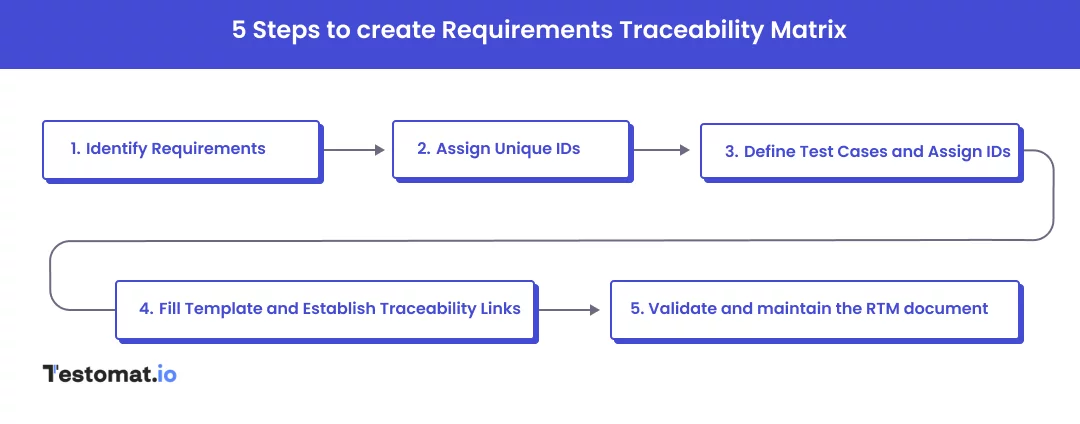
Let’s consider in details the key steps that you need to take for a successful creation:
#1: Identify Reqs
At this step, you should elicit all the project requirements from various sources, including stakeholders, project specs, and artifacts. Don’t forget that your requirements should be clear, specific, and well-defined in order to ensure alignment and minimize misunderstandings among all stakeholders, and boost the validation of each requirement.
#2: Assign Unique IDs
At this step, you should assign unique identifiers to each requirement. Having unique identifiers makes it easier for the teams to keep the evolving or changing requirements on track and handle them. Moreover, applying these identifiers linked to other project artifacts provides precise traceability throughout the project lifespan.
#3: Define Test Cases and Assign Test Case IDs
Once requirements have been identified and outlined, you should define test cases to validate each requirement. Each test case should be designed to cover a specific requirement. Additionally, it is imperative to assign unique IDs to each test case. These identifiers will show links for test cases and their corresponding requirements in the traceability test matrix.
#4: Create the traceability matrix Template and Establish Traceability Links
At this step, you need to set up a table or spreadsheet to create the requirements traceability matrix (RTM). Without a pre-defined template, you need to design the requirement traceability matrix (RTM) structure from scratch. You should decide on the columns you want to include in your RTM to capture the unique identifiers of requirements, their descriptions, and the appropriate test case identifiers. You can also customize the RTM columns based on your project’s specific needs. Once done, you can create links between the requirements and the corresponding project artifacts with unique identifiers. Here we have shown a basic traceability test matrix example:
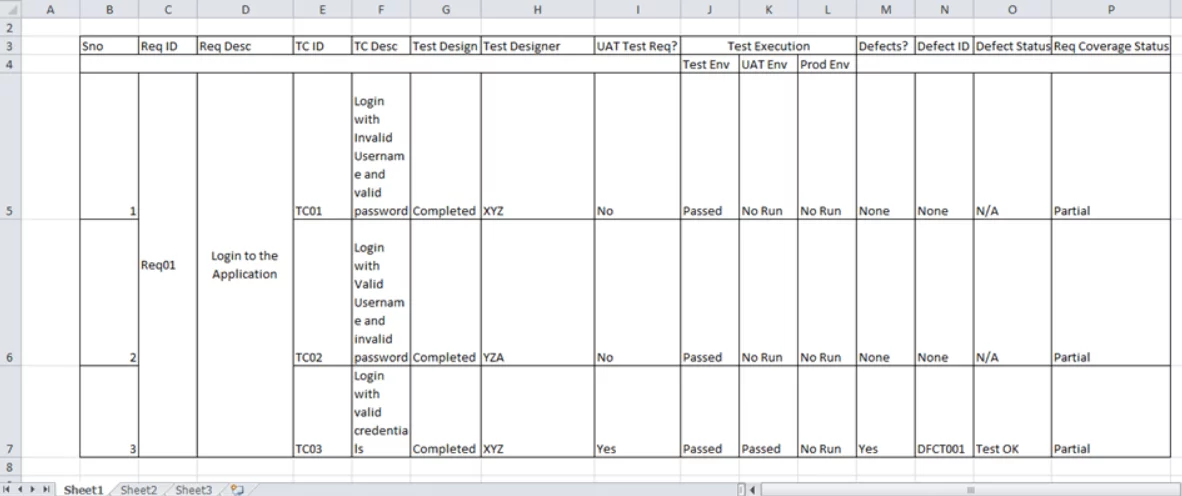
By linking requirements and their relevant test cases noted down in an RTM spreadsheet, QA teams can monitor and track the status and outcomes of each requirement during testing and development.
In practice, however, they can customize RTM with additional information and use additional columns to meet the project’s specific needs if required.
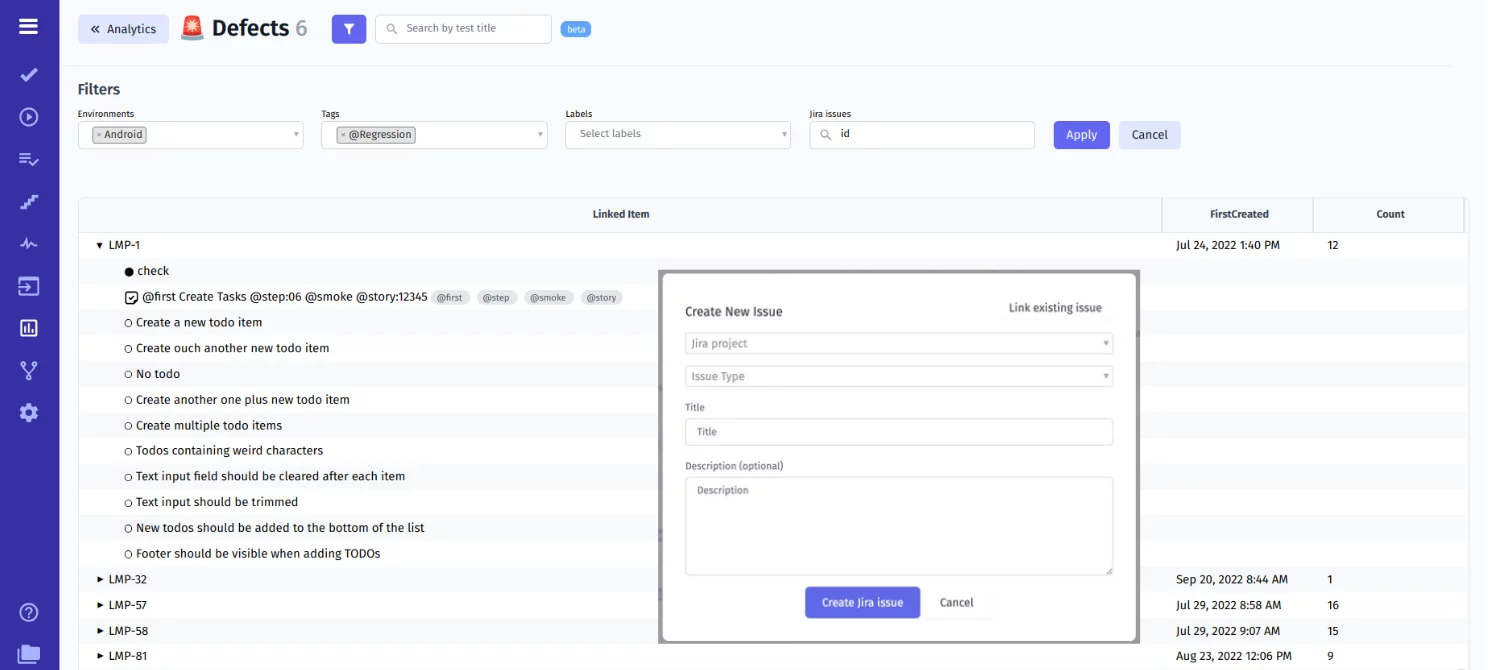
#5: Validate and maintain the RTM document
At this step, it is crucial to ensure that all test cases are mapped back to requirements and vice versa to confirm traceability both in terms of link correctness and completeness. In addition to that, you should keep the matrix updated – if any changes in requirements or new tests have been made. This helps prevent inconsistencies between requirements and test cases throughout the project lifecycle.
Benefits of using a requirements traceability matrix (RTM)
Requirements are a bridge between your business and your customer expectations. In fact, the majority of organizations that consider adopting an RTM document in project management, first and foremost, are looking for a way to improve the quality and traceability of the requirements in the testing phase. This means that they want to make sure each requirement in the documents is validated and tested. When describing the benefits of an RTM, we tend to focus on how the system can help you.
Here we are going to review the potential benefits of the requirements traceability matrix for your project:
- RTM provides a clear overview of how the project adheres to requirements and ensures that each of them is verified thoroughly.
- RTM allows the development staff to better handle modifications to existing requirements and other project artifacts, such as design documents, user stories, test scenarios, etc.
- RTM delivers a comprehensive record and displays requirements validation through the project’s lifecycle.
- RTM helps testers in prioritizing their efforts based on critically important requirements and reducing the risk of failures.
- RTM allows PMs, BAs, QAs, and stakeholders evaluate the state of requirement validation and make data-driven decisions.
- RTM eliminates gaps in test coverage and ensures that all specified functionalities are thoroughly tested.
What are the best practices for requirements traceability matrix (RTM)?
When it comes to creating a requirement traceability matrix, various challenges and limitations may hinder its effectiveness. That’s why having best practices for requirement traceability matrix implementation will help you maximize the benefits of RTM and integrate it seamlessly. Keep on reading to learn more details!
- Write clear requirements in a structured format. When creating an RTM, it is crucial to make sure that all project requirements are well-written and organized in a clear and structured format. This helps teams better understand whether requirements, test scenarios, and other artifacts are in line to eliminate traceability gaps in the testing process.
- Apply unique identifiers. Each requirement in the traceability matrix should have a distinct code to simplify the process of establishing links between requirements and test scenarios. What’s more, these links enable teams to trace and validate the relation between different components with ease, better manage changes, and improve the error detection process. When planning to integrate traceability matrix and test management tools, creating unique identifiers is vital to get different systems in sync.
- Prioritize. When giving priority to requirements, having a focus on high-priority requirements first allows teams to allocate resources effectively for testing and implementing the most vital features. If a list of high-priority requirements has been addressed early in the process of development, this helps teams mitigate project risks, detect potential issues, and deliver software products of high quality.
- Keep RTM up-to-date. It’s crucial to update the RTM regularly in order to monitor project progress and handle changes. This helps mitigate the risk and prevents data discrepancies between the documented requirements and actual implementation in advance.
- Promote workforce collaboration. With the RTM document, business analysts, developers, testers, business analysts, and other developers are on the same page about requirements visibility. This encourages effective communication and collaboration among them and helps in making data-driven decisions to drive great results.
Bottom line: Ready to drive better results by embracing RTM?
With an RTM document at hand, teams can significantly elevate the quality of software products. Requirements traceability matrix (RTM) drives a deeper understanding of the project’s scope, improves collaboration among stakeholders and teams, and optimizes testing efforts through comprehensive mapping of requirements, test cases, and issues.
In addition to that, it provides clear visibility into the entire testing activities and helps software development and project management teams catch potential inconsistencies in the project requirements. They can not only make deliberate decisions to ensure that all aspects of the software are tested thoroughly but also reduce the possibility of critical issues and errors.
👉 Drop us a line if you want to get a consultation on how to uncover the key benefits of the traceability matrices and perform testing activities more effectively.
Frequently asked questions
What is Traceability?

In the context of software development and project management, traceability involves tracking the lifecycle of requirements, ensuring that each requirement is linked to its corresponding design, implementation, and testing stages. This ensures that all requirements are accounted for and can be verified at each stage of SDLC.
What is a Requirements Traceability Matrix (RTM)?

A Requirements Traceability Matrix (RTM) is a document that helps track and manage the relationship between requirements and test cases throughout the Software Development Life Cycle. It ensures that all requirements correspond to test design and test cases. The RTM is a vital tool in project management. This approach maintains quality and compliance.
Why is Requirement Traceability Important?

Requirement traceability is vital for ensuring that all project requirements are met, facilitating change management, improving quality, enhancing accountability, supporting effective testing, and improving overall project management. It ensures that the final product aligns with stakeholder expectations and complies with regulatory standards, ultimately contributing to the success of the project
Who Needs Requirement Traceability?

Requirement traceability is a critical practice for a wide range of stakeholders, including project managers, business analysts, developers, QA teams, product owners, stakeholders, and consulting auditors.
Why is the RTM Matrix required?

The Requirements Traceability Matrix (RTM) is a crucial tool in project management and software development. Here are the key reasons why an RTM is required:
- Ensures Complete Coverage: RTM ensures that all requirements are implemented and accounted for, reducing the risk of missing any critical functionality.
- Test Coverage: Ensures that all requirements are covered by test cases, leading to more thorough testing and higher product quality.
- Verification: Helps in validating that each requirement has been addressed through design, implementation, and testing.
- Facilitates Change Management: RTM provides a clear view of how changes to requirements impact other project elements, enabling effective management of modifications.
- Consistency: ensures that changes are systematically updated across all related project artifacts, maintaining project consistency and integrity.
- Defect Tracking: Aids in tracing defects back to their corresponding requirements, facilitating efficient resolution.
- Project Progress Monitoring: allows project managers to track the status of requirements throughout the project lifecycle, providing better visibility and control.
- Risk Management: Identifies potential risks early by highlighting unfulfilled requirements, allowing proactive management.
- Documentation: Maintains a clear and organized record of how requirements have been addressed, supporting compliance and audit processes.
- Boosts Transparency: Offers stakeholders a clear view of how their requirements are being met, enhancing trust and confidence in the project’s progress.
- Accountability: Assigns clear responsibility for each requirement, ensuring accountability within the project team.
- Facilitates Communication and Collaboration.
- Alignment: Ensures that all team members are aligned with project goals and understand the connections between requirements and their implementation.
How to Create a Requirement Traceability Matrix (RTM)

Creating a Requirements Traceability Matrix (RTM) involves several steps to ensure that all project requirements are tracked and managed effectively throughout the project lifecycle. Here’s a steps on how to create an RTM:
- Gather Requirements
- Identify Requirements
- Document Requirements
- Define Traceability Levels
- Establish Relationships
- Set Up Categories
- Set Up the RTM Structure
- Create a Template
- Populate the RTM by Requirement ID, Description etc.
- Establish Traceability Links
- Status Track the status of each requirement (e.g., Not Started, In Progress, Completed, Tested).

